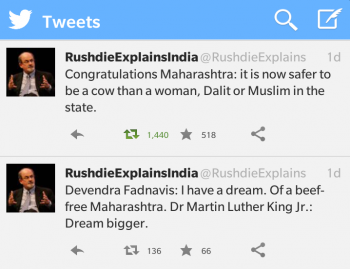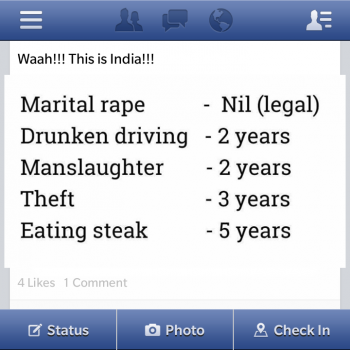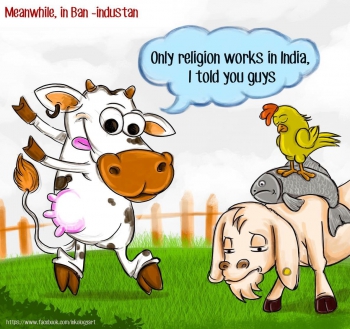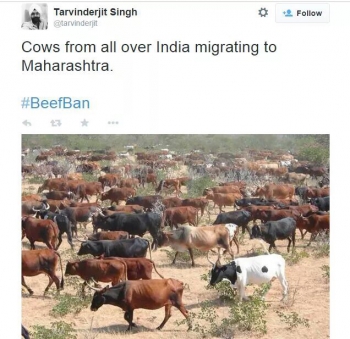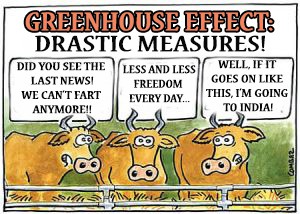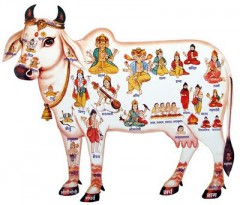03/08/2015
Cows 1 - Women 0
While I’m busy playing doll, a lot is happening in India! Budget must have required all the imagination of the authorities (and they needed some to increase the Defense envelope at the expenses of Health and Education). So now they must be jobless since their latest game is about banning things.
Starting with the movie Fifty Shades of Grey. In case showing a sexy movie to a big number of frustrated people would trigger some ideas – like if the said frustrated people had to go to the theater to see asses and tits ;) The party of the Prime Minister did not ban sexual education (in Maharashtra in 2007) to have bum slaps on big screens!
Then with the BBC documentary India’s Daughter about the Delhi gang-rape (and evisceration) of December 2012 - scary:
And with a grand finish, beef (and all the beef-family animals) have been banned in Maharashtra (including in Mumbai). This law, which not only punishes slaughter of cows but also possession and consumption, is obviously pro-Hindu, and too bad for the poor (beef meat being the cheapest), the Christians and the Muslims, the farmers and breeders and the poor old or dying animals.
More about the Sacred Cow in this post and this post.
But maybe the Government is doing all that on purpose, to attract attention on India (bad press better than no press)?? In this case, they got it right: sex, rape and cow worshiping, Westerners have developed a passion for these topics…
08:00 Posted in Funny things about India in photos, Incredible India! | Permalink | Comments (0) | Tags: india, cows, beef, beef ban, holy cow, rape, women, india's daughter, fifty shades of grey | ![]() Facebook | |
Facebook | |
02/22/2014
The golden cow!
One evening I needed something to cheer me up, a treat so I went to Santé (a tiny shop specialized in imported products) to... buy myself a steak! And the steaks they handed over to me ! I had not seen any steak so big in more than 8 years!! When I realised they came from the USA, I thought no wonder...
When came the time to pay, I cheerfully gave my card without even asking about the price: tonight my pleasure is priceless! But I withdrew it promptly from the hands of the cashier when I heard the amount: 3,500 rupees (€40)! For 700 grams of meat? At that price I’d rather go to Dubai and get a barbecue! I therefore left the steaks behind...
And I went to the Cold Storage (which is the closest thing to a butcher’s shop here). I asked for the tenderloin undercut – which is what I usually take, it is melting in the mouth, it is delicious. The only thing is that they only sell it by the piece and they had only one piece left and it was of 2 kgs. I already have a hard time finishing the 1 kg undercut (even if I freeze the steaks) so I decided it had to be a sign: no (holy) cow for dinner tonight! But the guy was a good salesman; seeing my disappointment he managed to sell me some cubes of local beef, 60 rupees to 300 grams. Haha!!
I was still recovering from the shock caused by the difference of price when the cubes of beef landed on my plate. Not only did I almost hurt my jaw with the chewing but also it wasn’t really tasty (I'm still wondering if it was not buffalo instead of beaf)... The next time I’ll stick to my undercut at 250 rupees per kilo!
More about cows, beef, worshipping, and everything here: http://www.indiandacoit.com/apps/search?s=beef
08:00 Posted in Expatriation (in India and in other countries), My stories in India | Permalink | Comments (0) | Tags: india, cow, beef, holy cow | ![]() Facebook | |
Facebook | |
10/04/2013
Why in India cows are sacred?
In my humble opinion, the cow is holy because, as everywhere (before industrialization), it is an animal that is super useful: it eats food waste, it provides cow-power to work in the fields, milk and dung (used as fertilizer, wall protection and combustible). And at the end of its life the cow also provides meat and leather. And two little add-ons in India: Panchagavya, a magical potion for plants and animals (including humans): it is prepared with five products from the cow (namely dung, urine, milk, curd, ghee (some fat product between oil and butter) with jaggery, banana, tender coconut and water. And Kambala, water buffalo races (see video).
Add all this to a (vague) tendency to venerate a more or less whatever comes their way and you get Indians worshipping cows! Simple...
Ah! Holy cow! Far from me the desire to stir up the debate as to whether it is good or bad to eat beef – I stopped preaching its nutritional qualities when I realized that if the billion of Indians was to eat it we may all end up suffocating in cow farts (sacred or not)!
Though it is worth highlighting that India holds the record for dairy cows (owning 15% of the 265 million animals populating the world (1)) and that, bad luck, dairy cows fart more than meaty cows (twice more exactly (2)). Pfffff as if Indians needed this additional pollution! Because, mind you, not only there are 38 million cows in India but also 100 million water buffaloes (3). And I don’t want to start thinking about buffalo farts!
Since we are at it, is a Buffalo holy or not? You need faith to worship such an ugly animal!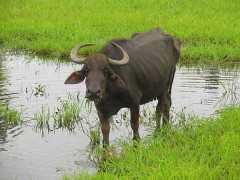 Joke apart, you get quite a shock when you are served a buffalo milk chai (yucky for me) or when you cook your first buffalo steak (thinking you bought beef) and it gives away yellow fat. So buffalo? Sacred or not sacred?
Joke apart, you get quite a shock when you are served a buffalo milk chai (yucky for me) or when you cook your first buffalo steak (thinking you bought beef) and it gives away yellow fat. So buffalo? Sacred or not sacred?
Well it depends on the States... Sometimes the bull, bullock and buffalo are considered as cows (in addition to the cow itself, the calf and the she-buffalo); sometimes not.
Sometimes, the "sacredness" of the cow can be waived: if it exceeds a certain age or if it is no longer viable (i.e. able to produce milk or calves or to pull a plough), even if in all cases it is necessary to ask for authorisation before euthanizing a cow; sometimes not.
Sometimes (especially in Kerala, West Bengal and North-eastern States) the cow is simply not "legally" sacred and there are 3,600 legal slaughter houses (and 32,000 illegal ones which provide 70% of the meat) (4); someone has to feed all the communities of beef-eaters (Christians, Muslims and indigenous tribes, for example). And even if they are minorities, on a basis of one billion people, as much buffalo is eaten in India as beef in France every year! It is a real business. There is even a big cow-trafficking from India to the neighbouring (beef-loving) countries (5).
The Indian Constitution does not ban cow-slaughtering but protect the animal: “The State shall endeavour to organise agriculture and animal husbandry on modern and scientific lines and shall, in particular, take steps for preserving and improving the breeds, and prohibiting the slaughter, of cows and calves and other milch and draught cattle.” (Article 48)
De facto, the States have their own Prevention of Cow Slaughters Acts and the right to ban or restrict it and penalize it (6) (the killing of a cow can be punished with imprisonment (up to 7 years) and/or a fine (up to 50,000 Rs)). With as many as 28 different states and rules that change at the discretion of the governments, difficult to know where you stand!
It is indeed a verrrry sensitive topic in India and politicians don’t hesitate to use it. For instance, a story of cartridges coated with cow and pig fat almost led the Britishers to lose their colony in 1857 (7)!
Another example is the anti-cow slaughtering riots that shook India in August 1893 and caused a hundred deaths: while two festivals (Hindu and Muslim) coincided in Bombay, the press reported the sacrifice of a cow by the Muslims and things got out of control (8).
Just to say that Hindu politicians do not hesitate to invoke the holiness of the cow to agitate crowds and win votes...
Every year a water buffalo (Kambala) takes place in Kasargod (Kerala)
Next we will see why cows are free to wander in the streets in India!
(1) “India became the first world nation in milk production in 2001, ahead of the USA. In 2010, Indians produced 108 million tonnes whereas they were at 19 million 40 years earlier. Launched by the Government in 1970, the country operated a 'white revolution '. The goal: to achieve self-sufficiency to feed the population and fight poverty by providing an additional income to farmers. The number of cows is huge but the structure remains very traditional, because of religion. The cow is considered a sacred animal.” In addition, “the global production is dominated by cow milk which represents 83% of the quantities produced in 2010. Far behind, bufallo milk weighs 13%. She-buffalo milk is not common in Europe and is mainly collected in Asian countries (India, Pakistan, China).” Sources: http://www.produits-laitiers.com/Economie-et-Societe/filiere/Monde/; http://www.lemangeur-OCHA.com/Ouvrage/cultures-des-laits-du-Monde/; http://www.FAO.org/AG/againfo/programmes/FR/PPLPI/docarc/pb_wp2.html; http://www.lebulletin.com/Autres/l%E2%80%99inde-Domine-avec-38-millions-de-Vaches-30113
(2) For reasons of growth and nutrition. Source: http://www.crioc.be/files/fr/4128fr.pdf
Cow farts: the advantage of cattle is that they can feed exclusively on grass through their four stomachs and their bacteria. The downside is that this digestive specificity produces large quantities of methane, a gas contributing to the greenhouse effect and global warming. Sources: http://www.crioc.be/files/fr/4128fr.pdf; http://www.challenges.fr/Industrie/20130828.CHA3458/Le-Poisson-d-Elevage-s-EST-fait-plus-Gros-que-le-b-UF.html
(3) Buffalo:http://www.buffalopedia.cirb.res.in/index.php?option=com_content&view=article&id=60&Itemid=65&lang=en; http://en.wikipedia.org/wiki/Water_buffalo
(4) Sources: http://www.academia.edu/929980/Negotiating_the_SacredCow_Cow_Slaughter_and_the_Regulation_of_Difference_in_India;
http://drfoxvet.com/library/info/india-sacred-suffering-holy-cow
(5) 1.15 tonnes of buffalo consumed in India every year and 1.55 tonnes of beef in France.Sources: http://blogs.independent.co.uk/2012/04/30/food-fascism-the-vegetarian-hypocrisy-in-india/; http://www.planetoscope.com/elevage-viande/1587-consommation-de-viande-de-boeuf-en-france.html
Source on cow trafficking: http://www.csmonitor.com/world/global-news/2013/0126/cow-smuggling-it-s-how-Bangladesh-gets-its-beef
(6) 'The Article 48 of the Indian Constitution directs the State to take necessary steps for prohibiting the slaughter of cows and calves” Source: http://blogs.independent.co.UK/2012/04/30/food-fascism-the-vegetarian-hypocrisy-in-India/
Other sources: http://www.academia.edu/929980/Negotiating_the_SacredCow_Cow_Slaughter_and_the_Regulation_of_Difference_in_India; http://articles.timesofindia.Indiatimes.com/2012-12-16/Bangalore/35850723_1_cow-slaughter-preservation-of-cattle-Bill-cattle-Prevention-Act
(7) The protection of the cow started to gain importance in 1857, four years after new cartridges were introduced with greased paper. To open the cartridge, the sepoys (Indian soldiers of the British Army) had to tear off the paper with the teeth. A rumour started that the fat used was a mixture of pork and beef fat. And boom, both Hindu and Muslim sepoys rebelled (it was the last straw) and it took a year to put down the rebellion. And yes, the Indian independence process did not happen only through nonviolence. Sources: http://asianhistory.about.com/od/india/f/What-Was-The-Revolt-Of-1857-in-India-All-About.html; http://www.sjsu.edu/people/shantanu.phukan/courses/114/s1/Metcalf-Early%2020th%20Century%20India%20&%20Colonial%20Resistance.pdf
(8) http://paperspast.natlib.govt.nz/cgi-bin/paperspast?a=d&d=THD18931006.2.34
08:00 Posted in Why in India... | Permalink | Comments (0) | Tags: panchagavya, cow, holy cow, hinduism, dung, urine, milk, ghee, buffalo, she-buffalo, calf, bullock, dairy cow, environment, fart, slaughter, beef, meat, vegetarian, non-vegetarien, constitution, law, water buffalo, kambala, kerala, buffalo racing, cow fart, gaz, cow-trafficking | ![]() Facebook | |
Facebook | |















